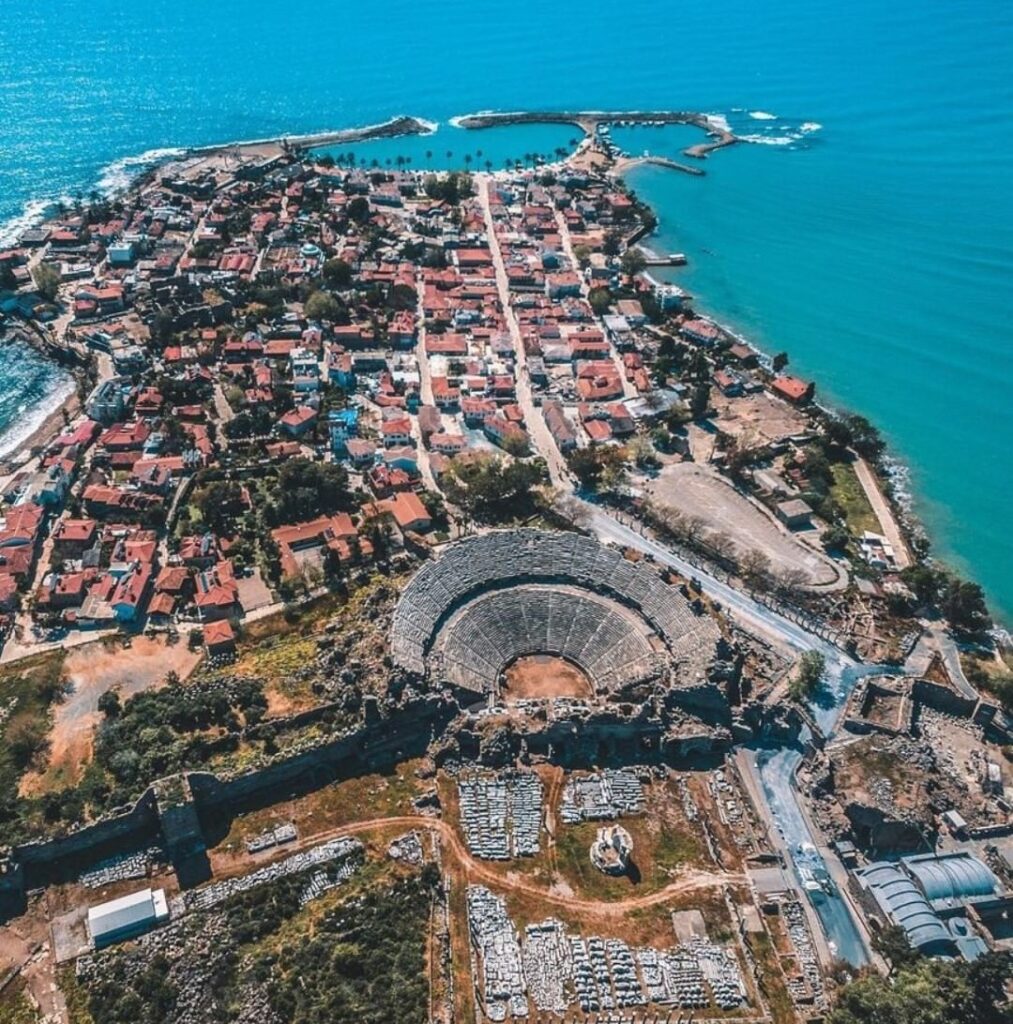
When making your vacation plans, I would say do not skip this peninsula. Because Side is a beautiful historical peninsula where you will admire the historical textures while traveling and witness all the experiences on the spot, enjoy the sea and Apollo’s greeting the sun.
Table of Contents
“How can I go to the Side Ancient City?”
The Side Ancient City is located in the Manavgat District, 75 km east of Antalya. To reach it, you can head towards the Side Neighbourhood. Alternatively, you can also take the Side buses from the city centre according to your preference.
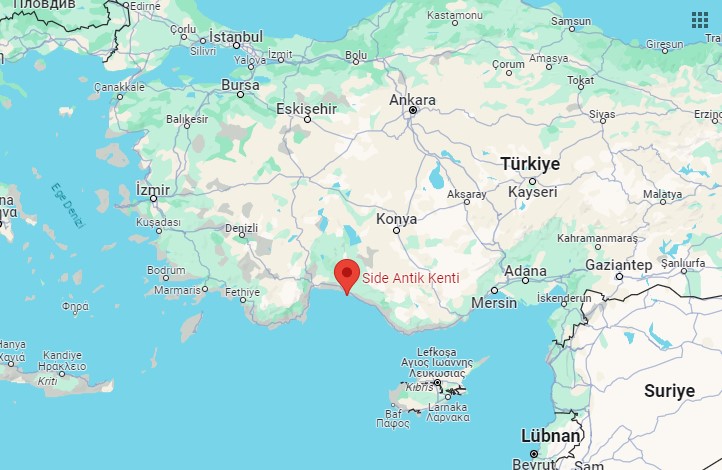
CLICK TO GO
General Info
Side, the most important port city of Pamphylia in ancient times, was established on a peninsula that was 350-400 metres wide. It is located 80 kilometres east of Antalya and 7 kilometres southwest of Manavgat.
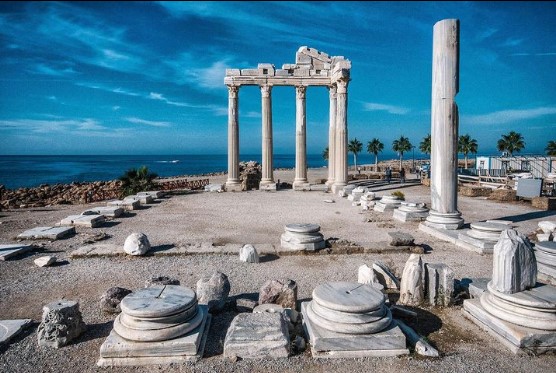
Side is a peninsula located in the Manavgat district of Antalya. It is believed to have been established before the 7th century BC and is named after the pomegranate, which was considered a sacred fruit by the ancient Anatolian goddesses. The emblem of the city is also a pomegranate. According to inscriptions, the language spoken in Side was called “Sidece” and was specific to the city until the 3rd century BC. Although Sidece is believed to have been a language of Luwian origin spoken by the indigenous people of Anatolia, it is still not fully analyzed and is considered one of the Indo-European languages. Throughout history, Side was ruled by several empires, including the Hittites, Lydians, Persians, Romans, Byzantines, and Ottomans.
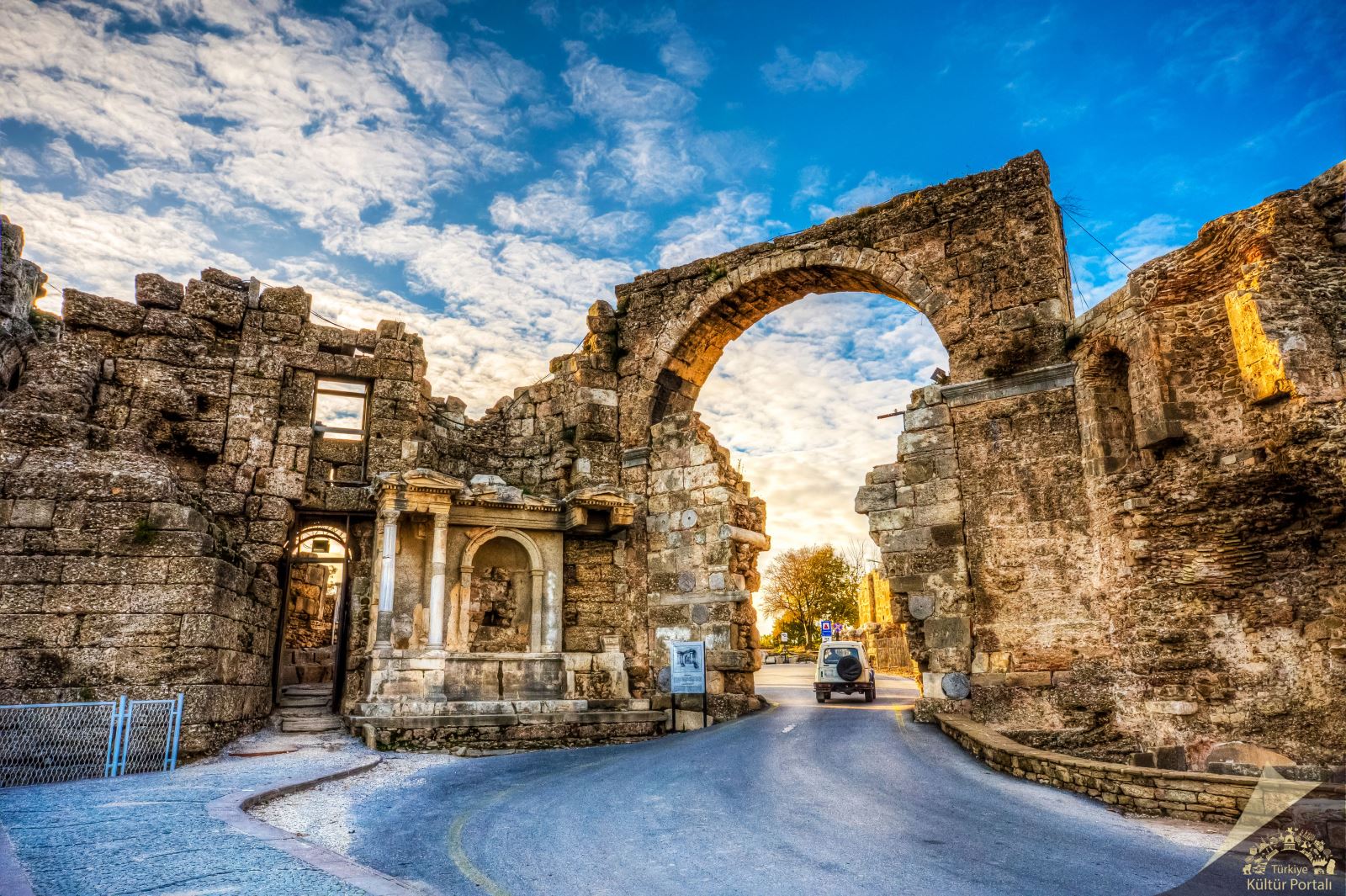
Photo: Turkey Culture Portal
History
Side was established as a settlement center in the 7th century BC. It came under the rule of the Lydian Kingdom in the 6th century BC, along with the rest of Pamphylia. After the fall of the Lydian Kingdom in 547/46 BC, it was ruled by the Persians. During this period, the city managed to maintain some of its freedom and even minted its own coins.
In 334 BC, Side welcomed the Macedonian king, Alexander the Great, without any resistance during his Anatolian campaign. Later, it became one of the major coin minting centers established by Alexander.
After Alexander’s death, Side constantly changed hands between different kingdoms during the Hellenistic period. It came under the rule of the Ptolemies in the 3rd century BC, and later under the Seleucids in 215-189 BC.
Following the Seleucids’ defeat in the war against the Romans, the Apameia Peace treaty of 188 BC granted Pamphylia and Side to the Bergama Kingdom. However, Side regained its independence after some time and experienced one of the brightest periods in its history.
.jpg)
Photo: Servet Uygun
It is worth noting that Side was an important cultural center in the Eastern Mediterranean during its time. Unfortunately, this period of prosperity did not last long. Piracy began to spread in the regions of Pisidia and the mountainous Cilicia during the 1st century BC, then it spread to Pamphylia and eventually reached Side. The Sidelis were unable to fight the pirates and had to allow them to use their harbors and markets. Finally, in 78 BC, the Roman Consul Publius Servilius saved the region from pirates, and Side, like other cities in Pamphylia, was incorporated into the Roman Empire.
.jpg)
Photo: Gülcan Acar
In 25 BC, Augustus established Pamphylia as a province under his direct authority. As a result, Side became a city of the Roman province. During the 2nd and 3rd centuries AD, Side flourished, but by the 4th century, it had become a poor Christian city. Side’s third and final period of prosperity occurred during the 5th and 6th centuries, when it became the capital of the Eastern Pamphylia Metropolitanate. However, in the 9th and 10th centuries, Arab raids weakened the city, and it was referred to as a “nest of pirates” by Byzantine Emperor Constantinos Porphyrogennetos in his work “De Thematibus”. The Arab geographer Idrisi called Side “Burnt Antalya” and reported that its inhabitants had been relocated to “New Antalya”, two days away.
The village of Selimiye Village was established by Gyrgyrian immigrants in the early 20th century on the ruins of the ancient city known as Side. The city of Side was built on a peninsula and is characterized by a monumental street that begins from the main gate of the city and extends along the peninsula. This main street runs almost straight except for the curve in front of the Theater, and ends with a large square near the temples. The city’s second major street extends from the “Great Gate” towards the south of the city, and both streets are lined with colonnaded porticos with Corinthian capitals on both sides and a row of shops behind them.
.jpg)
Details about the Monuments
After leaving the main road, you will enter through the main gate of the land walls that surround the city. These walls date back to the 2nd century BC and are protected by two towers located nearby. Once you pass through the gate, you will see the 9 running fountains of the monumental fountain (Nymphaeum), which has three large niches on the roadside. The structure, known as the 9 fountains, gets its origin from the Manavgat Stream. The building is 20 meters high and 52 meters wide, but due to earthquakes, its height has decreased to 12 meters. Despite the restoration work, the fountain does not flow, but it is still a fascinating sight to see in its roughly finished form.
Right next to the fountain you can see 2 colonnaded roads. The main colonnaded road is occupied by traffic and if you continue on this road, small small shops, agora, theater, baths and houses on the sides take you to the port of the city. The second one starts just to the left of the fountain and ends at the harbor and the temples. Isn’t it an interesting coincidence that both colonnaded streets intersect the harbor? =)
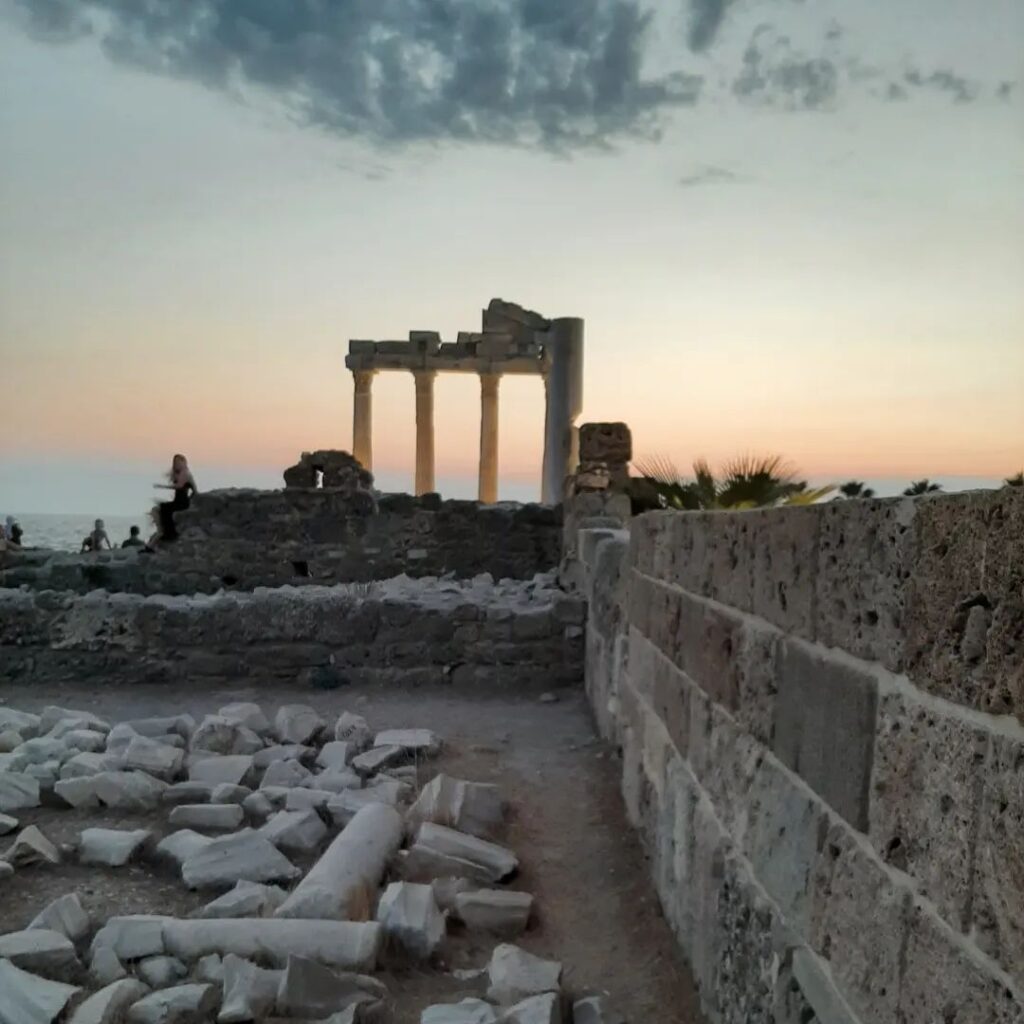
As we continue on the main colonnaded road, we come across the Vespasianus fountain and get to see the shops and houses of the time. The Vespasianus fountain is located at the narrowest point of the peninsula, and next to it stands a 15-meter-high arch, which is one of the few structures that have survived in all its splendor. Unfortunately, today, traffic flows through this gate, which is really sad due to geographical inadequacy and technical impossibilities. However, it is very difficult to change this situation.
Once you pass through this arch, you will see the theater, which is one of the rare structures of Side. The theater dates back to the 2nd century AD and is 20 meters high, with a capacity of approximately 15,000 people. The stage building has three floors, and what makes this theater unique is that it was built on arches due to its geographical location, whereas all other theaters were built behind the mountain. In the Roman period, the orchestra part was surrounded by railings for gladiator and wild animal struggles, and in the Byzantine period, the theater was used for Christian rituals and had architecturally rich ornaments. Outside the theater, there is a gallery with 14 shops and 5 entrances.
.jpg)
Located next to the theater, the bathhouse was constructed in the 5th century AD. After being restored in 1962, it was converted into a museum. The bathhouse consists of four parts: dressing rooms (Apodyterium), warm room (Tepidarium), hot room (Caldarium), and cold room (Frigidarium). Upon entering the museum, which is also known as the hammam, you can observe the hot water pipes under the walls. This tradition has continued from Byzantine to Ottoman times and has survived to the present day. Many artifacts belonging to the Hellenistic, Roman, and Byzantine periods such as inscriptions, sculptures, sarcophagi, portraits, amphoras, and tomb steles are exhibited in the museum. Most of these artifacts were excavated by Prof. Dr. Arif Müfid Mansel.
Adjacent to the theater, you can also find the Temple of Dionysus. This temple, belonging to the early Roman period, is situated right next to the Vespasianus monument. Although there is little information about the building, it is believed to date back to the Hellenistic period. With the spread of Christianity, the temple lost its significance during the Byzantine period and was used for other purposes.
The agora, which played a significant role in decision making during those times, can be seen from the theater but is currently unavailable for entry due to ongoing excavations.
As you enter the city, you will notice two colonnaded roads. Once you enter the colonnaded road, which extends from the monumental fountain, you will be greeted by the Gymnasium. Covering a large area, this is one of the places that fulfills the saying that a sound mind is found in a sound body. It is not difficult to see why, given its size. The temple of Tyche, the goddess of luck and the patron goddess of the city, is situated right in the middle of the Gymnasium and the Theater. This temple is quite unique in its structure, which is not commonly seen in Anatolia. It is believed to be a copy of the temple in the city of Antioch and was built in the 2nd century A.D. However, we cannot answer why the temple was not built in the middle of the city like the Roman agoras. The temple sits on a 2-meter platform and is surrounded by a gallery with 12 columns.
As you walk towards the temples of Athena and Apollo in the ancient city of Side, you may notice pomegranate trees on either side. Side has a connection with pomegranates due to a mythological story. Side, the goddess of nature and fertility, went to the shore of Melas (Manavgat) with her daughter and forest nymphs to collect flowers. She broke a branch from a colorful tree to give the flowers to her daughter, not realizing that the tree was actually a goddess who had turned into a tree to protect herself from harm. As a result, Side was unable to move and became rooted to the ground, with leaves sprouting from her fingers.
Symbol of Side Ancient City
The forest nymphs cried and wet Side’s feet with their tears. Side then declared that she would become the symbol of nature and life with her blood-colored fruits, and asked that her daughter visit often and play in her shade without picking any flowers, to respect all trees and flowers as possible goddesses in disguise. This is why Side is full of pomegranate trees. Although the symbol of the city is the pomegranate, the temple of Apollo is what is usually shown on postcards. This temple, dedicated to the god of light, beauty, and art, has been restored and still stands today with 5 columns and Corinthian capitals. The temple was dismantled by the Byzantines to be used in the construction of a basilica, but it remains a worthwhile heritage site to visit. You can also see the ruins of the temple dedicated to the moon god Men in Side, which was believed in before Athena and Apollo.
Source: Side, Antalya from Yesterday to Today Volume II, Antalya Provincial Directorate of Culture and Tourism (2012)

Excellent write-up
PBN sites
We shall build a system of private blog network sites!
Pros of our privately-owned blog network:
We carry out everything so GOOGLE DOES NOT comprehend that this is A PBN network!!!
1- We buy domains from separate registrars
2- The principal site is hosted on a virtual private server (Virtual Private Server is high-speed hosting)
3- The remaining sites are on different hostings
4- We assign a unique Google account to each site with confirmation in Search Console.
5- We create websites on WordPress, we don’t employ plugins with aided by which malware penetrate and through which pages on your websites are created.
6- We do not duplicate templates and use only exclusive text and pictures
We do not work with website design; the client, if desired, can then edit the websites to suit his wishes